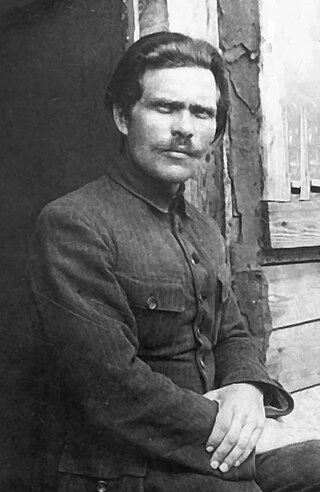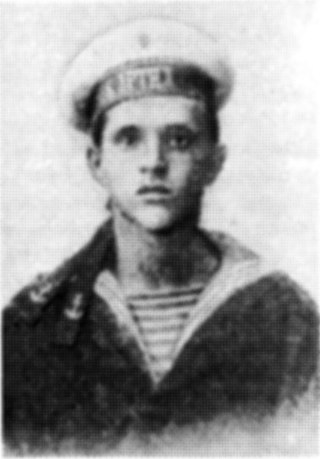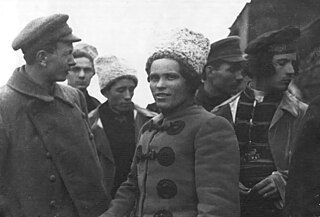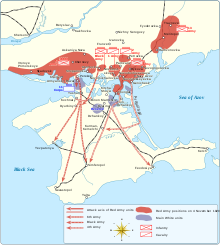
Peter Andreyevich Arshinov, was a Russian anarchist revolutionary and intellectual who chronicled the history of the Makhnovshchina.

Nestor Ivanovych Makhno, also known as Bat'ko Makhno, was a Ukrainian anarchist revolutionary and the commander of the Revolutionary Insurgent Army of Ukraine during the Ukrainian War of Independence. He established the Makhnovshchina, a mass movement by the Ukrainian peasantry to establish anarchist communism in the country between 1918 and 1921. Initially centered around Makhno's home province of Katerynoslav and hometown of Huliaipole, it came to exert a strong influence over large areas of southern Ukraine, specifically in what is now the Zaporizhzhia Oblast of Ukraine.

Dmitry Ivanovich Popov was a Russian sailor and Left Socialist-Revolutionary that led the Left SR uprising against the Bolsheviks in July 1918. Following the suppression of the uprising, he joined the Revolutionary Insurgent Army of Ukraine and became a leading member, spearheading the negotiations between the Makhnovists and the Bolsheviks until his arrest and execution by the Cheka.
The Makhnovshchina was a mass movement to establish anarchist communism in southern and eastern Ukraine during the Ukrainian War of Independence of 1917–1921. Named after Nestor Makhno, the commander-in-chief of the Revolutionary Insurgent Army of Ukraine, its aim was to create a system of free soviets that would manage the transition towards a stateless and classless society.

Viktor Fedorovych Bilash was a Ukrainian military commander who was the Chief of Staff of the Revolutionary Insurgent Army of Ukraine (RIAU) under Nestor Makhno during the Russian Civil War. A gifted military commander, Bilash himself planned many of the Insurgent Army's operations, later becoming its commander in chief after Makhno's flight into exile.

Semen Mykytovych Karetnyk was a Ukrainian anarchist revolutionary and military commander in the Revolutionary Insurgent Army of Ukraine (RIAU). He often replaced Nestor Makhno as supreme commander of the Insurgent Army in 1920. Karetnyk gained a reputation for his central role in defeating the White Army in Crimea in November 1920.

Lev Mykolaiovych Zadov, also known by his nom de guerreLev Zinkovskyi, was chief of military intelligence of the Revolutionary Insurgent Army of Ukraine (RIAU) and later an operative of the Joint State Political Directorate (OGPU).
The Nabat Confederation of Anarchist Organizations, better known simply as the Nabat, was a Ukrainian anarchist organization that came to prominence during the Ukrainian War of Independence. The organization, based in Kharkiv, had branches in all of Ukraine's major cities. Its constitution was designed to be appealing to each of the different anarchist schools of thought.
Free soviets were the basic form of organization in the Makhnovshchina. These soviets acted independently from any central authority, excluding all political parties from participation, and met to self-manage the activities of workers and peasants through participatory democracy.

The Revolutionary Insurgent Army of Ukraine, also known as Makhnovtsi, named after their founder Nestor Makhno, was an anarchist army formed largely of Ukrainian peasants and workers during the Russian Civil War. They protected the operation of "free soviets" and libertarian communes by the Makhnovshchina, an attempt to form a stateless anarcho-communist society from 1918 to 1921 during the Ukrainian War of Independence.
The Battle of Peregonovka or Battle of Perehonivka was a September 1919 military conflict in which the Revolutionary Insurgent Army of Ukraine defeated the Volunteer Army. After retreating west across Ukraine for four months and 600 kilometers, the Insurgent Army turned east and surprised the Volunteer Army. The Insurgent Army reclaimed its capital of Huliaipole within ten days.

Agafya "Halyna" Andriivna Kuzmenko was a Ukrainian teacher and anarchist revolutionary. After moving to southern Ukraine, she became a prominent figure within the ranks of the Makhnovshchina, a mass movement to establish a libertarian communist society. Kuzmenko spearheaded the movement's educational activities, promoted Ukrainization and acted as an outspoken advocate of women's rights. Along with her husband, the anarchist military leader Nestor Makhno, in 1921 she fled into exile from the political repression in Ukraine. While imprisoned for subversive activities in Poland, she gave birth to her daughter Elena Mikhnenko, whom she brought with her to Paris. Following the death of her husband, the outbreak of World War II saw her deportation for forced labour, first by the Nazis and then by the Soviets. After her release, she spent her final days with her daughter in Kazakh SSR.

The Military Revolutionary Council was the de facto executive of the Makhnovshchina, empowered to act during the interim between sittings of the Regional Congresses.

The Regional Congresses of Peasants, Workers and Insurgents represented the "highest form of democratic authority" within the political system of the Makhnovshchina. They brought together delegates from the region's peasantry, industrial workers and insurgent soldiers, which would discuss the issues at hand and take their decisions back with them to local popular assemblies.

The Battle of Dibrivka was a military conflict between Ukrainian insurgents, led by Nestor Makhno and Fedir Shchus, and the Central Powers that were occupying southern Ukraine. It took place on 30 September 1918, towards the end of World War I. The battle began when Makhno, Shchus, and a group of anarchist supporters ambushed Austrian and Ukrainian detachments stationed in Dibrivka. The anarchists were armed with machine guns and were assisted by local peasants, who together captured ammunition, arms, and prisoners of war. It resulted in an insurgent victory and the establishment of an autonomous territory in the region, following the subsequent defeat of the Central Powers.

Oleksiy Ivanovych Marchenko was a Ukrainian anarchist military leader, who fought in the war of independence as a cavalry commander in the Revolutionary Insurgent Army of Ukraine.

Foma Kozhyn was a Ukrainian revolutionary and the commander of the machine-gun regiment of the Revolutionary Insurgent Army of Ukraine.
The Road to Freedom was the main newspaper of the Makhnovist movement, publishing 50 issues from May 1919 to November 1920.
The Kontrrazvedka was the counterintelligence division of the Revolutionary Insurgent Army of Ukraine. Its main functions were to carry out military reconnaissance, the prosecution of captured enemies and counter-insurgency operations.
The Bolshevik–Makhnovist conflict was a period of political and military conflict between the Ukrainian Soviet Socialist Republic and the Makhnovshchina, for control over southern Ukraine. The Bolsheviks aimed to eliminate the Makhnovshchina and neutralise its peasant base. In turn, the Makhnovists fought against the implementation of the Red Terror and the policy of war communism.

















